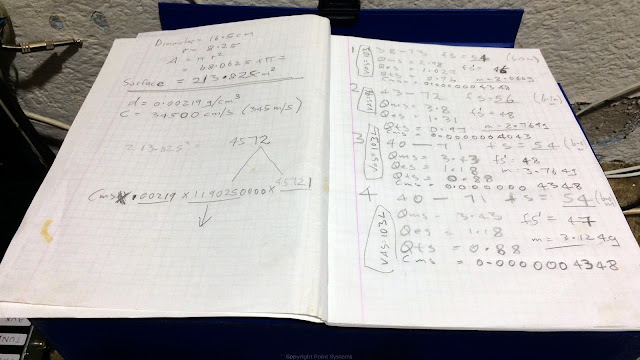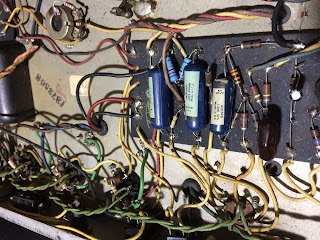Monday 29 November 2021
TELEDYNE ACOUSTIC RESEARCH AR25 SPEAKERS
Sunday 28 November 2021
Waldorf School, Project Year, Loudspeaker Design
Waldorf High Schools like Michael Oak Waldorf School tuition covers all the requirements of the SA Schools syllabus, but also offers a richer depth of learning.
The subwoofer featured in this article, was part of my son's Class 12 project at Constantia Waldorf School for that year.
Michael Oak did not have a high school at the time.
Brief summary of the design strategy:
I worked for Prosound in Johannesburg during the '80s and early '90s, running an R&D department that was tasked to produce assembly-line-style professional sound equipment on demand.
For example, we had less than 2 weeks to prepare and deliver everything that was required for Paul Simon concerts.
Ad Valorem taxation applied to the components we stocked.
It's basically a disincentive to produce certain commodity items locally, such as:
"Motor Vehicles, Electronic Equipment, Cosmetics, Perfumeries and other products generally regarded as “luxury items” ".
Armed with my EV equipment, experience and familiarity with Thiele-Small speaker alignment based on Chebyshev filters, my son and I worked our way through the design process and ended up with what is presented below:
The Sub Woofer 13 years later (November 2021):
The Workshop (May 2008):
Wednesday 24 November 2021
NAD 3140 Amplifier Proposed Restoration
The NAD 3140 Stereo Integrated Amplifier came onto the market circa '80.
Features such as infrasonic and ultrasonic filters, current "dumping", soft clipping, bridged operation and a dual power supply, put NAD's international design team beyond the convention at the time.
Above listed electrolytic capacitors need to be replaced.
After a clean-up (with Isopropyl) and BIAS adjustment the Amp will be as good as new.
The 4th Wave
Monday 22 November 2021
Tube Rectifier "Sag"
General
One of the terms you often hear in discussions about tube guitar amplifiers is "sag". Sag refers to the drooping of the power supply voltage in response to large transient signals, which lends a certain dynamic "feel" to the tube amplifier that is not generally found in solid-state amplifiers.
What causes it?
There are three main places where sag occurs in a tube amplifier:
- The rectifier: If a vacuum tube rectifier is used, sag is generated because of the internal resistance of the tube. Unlike a solid-state rectifier, a tube rectifier exhibits a fair amount of voltage drop which varies with the amount of current passing through the tube. In a class AB amplifier, the current drawn from the power supply is much greater at full power output than it is at idle. This large change in current demand causes the voltage drop across the tube rectifier to increase, which lowers the available plate supply voltage to the output tubes. This lowering of the supply voltage lowers the output power slightly in opposition to the larger input signal, making it act like a compressor. The lowered supply voltage also tends to decrease the available headroom, increasing clipping and changing the operating point of the tube dynamically. This type of sag can be emulated artificially in an amplifier with a solid-state rectifier by adding a series resistance, typically around 100 ohms or so..
- The transformers: The resistance of the high-voltage secondary winding also creates sag. From Ohm's Law, the voltage drop across a resistance is equal to the resistance multiplied by the current flowing through it. This means that there is no voltage drop if there is no current, and the amount of voltage drop goes up linearly with increases in current draw. A typical power transformer B+ winding might have a resistance of 50 ohms - 300 ohms, depending upon the current rating and regulation of the transformer. For example, if the current draw in a push-pull class AB output stage at idle is 70mA total, and it increases to 170mA at full power, there is a change of 100mA in the current drawn through the secondary windings. If the winding resistance of the secondary is 200 ohms, there is a voltage drop of 100mA*200 ohms = 20V in the plate voltage to the output tubes. Likewise, the resistance of the primary winding of an output transformer varies as well, typically 80 ohms - 200 ohms plate-to-plate, depending upon the primary inductance, the transformer power rating, and the rated impedance. This resistance also creates a voltage drop, but the amount of sag introduced is minimal in pentode mode, because the plate voltage doesn't have near as much effect on the plate current as does the screen voltage. In triode mode, there is more sag because the plate voltage has more of an effect on plate current in a triode. The supply sag created by the power transformer resistance lowers not only the plate voltage, but the screen voltage as well, since the screen is nearly always a filtered version of the supply going to the plate. The amount of sag induced by the power transformer winding can be offset if there is a large filter capacitor reservoir to hold the voltage constant during current peaks.
- The filter capacitors: The size of the filter capacitors in relation to the amount of current drawn from the power supply also creates sag. The filter caps charge up during the peaks of the AC input cycles, and hold the voltage constant during the "valleys". If the ratio of peak to idle current is high, and the peak current demands are high in relation to the capacitance size, the voltage will sag appreciably during the valleys, creating a lower average voltage. If there is no further filtering, there will also be a 120Hz sawtooth ripple riding on the B+ supply. This normally doesn't induce much hum into the output stage because of the inherent power supply rejection afforded by the push-pull output stage, and the screen supply is usually filtered further with a choke and another capacitor. However, insufficient filtering can induce ripple into the amplifier if the output stage is not well balanced, or if the screen and preamp supplies aren't well filtered.
The downside of sag
Sag creates a certain amount of compression, but it also can have bad side effects, the worst of which is "ghost" notes. Ghost notes are notes that are "riding on top" of the guitar note, not generally harmonically related to the note being played. This can be a bit disconcerting when it is mixed in with the guitar tone. The ghost notes are usually caused by inadequate power supply filtering, which allows a 120Hz component to modulate the guitar signal. (The frequency is 120Hz because of the full-wave rectification of the 60Hz supply. It would be 100Hz in countries that use 50Hz mains power.).Note that sag effectively only occurs in class AB amplifier output stages. A true class A amplifier has no sag because the current draw at full power is the same as the current draw at idle. However, most class A amplifiers aren't biased exactly at the midpoint of the range, and will tend to clip asymmetrically, especially when going into grid clamp on the output tubes, so there will be an offset current component, but it will be much smaller than in a class AB output stage.
Another term: "squish"
An effect similar to sag is produced by cathode-biased amplifiers because the increased current through the power tubes increases the voltage drop across the bias resistor, which in turn decreases the current through the tube, with a time constant dependent upon the size of the bypass capacitor in relation to the cathode resistance. This compression effect is commonly referred to as "squish" to differentiate it from "sag", which applies only to compression induced by power supply droop. "Squish" also is used when referring to the effect produced by the transient recovery time of AC-coupled amplifier stages. A sharp transient temporarily increases the effective negative bias, and the time constant of the RC coupling determines the recovery time following the transient. Long time constants caused by large coupling capacitors in conjunction with large grid resistor values will increase the amount of squish in an amplifier. Too long a recovery time leads to "blocking" distortion. This is why it is not a good idea to use overly large coupling capacitors in the output stage of a guitar amplifier.
Copyright 1999, Randall Aiken. May not be reproduced in any form without written approval from Aiken Amplification.
Friday 19 November 2021
Jordan Peterson - Uncommon Sense
New Yorker: "Peterson is now one of the most influential—and polarizing—public intellectuals in the English-speaking world"
Thursday 18 November 2021
Steenbeck Film Editing
Former BBC film editors Dawn Trotman and Oliver White demonstrated the use of Steenbeck and Acmade PicSync film editing equipment, while breaking down documentary rushes and assembling them into rough sequences.
AKAI RTR about to depart from Cape Town to Rustenburg
About to depart Cape Town
Copyright Bradshaw Leigh 2013
www.analog-tape.com
Saturday 13 November 2021
Fender Showman 1965 - Full restoration
The eagle has landed from Jeffreys Bay
Thanks to John from ToneTubes for excellent service
Not OK.
When the toggle points to "Standby"
it means, not standby.













































































